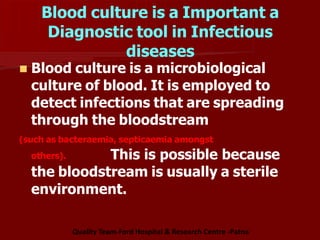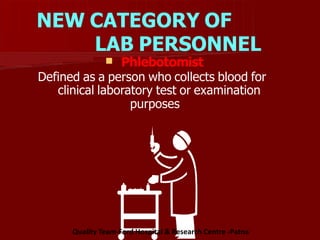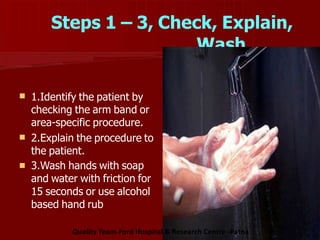Blood culture
- 1. AUTOMATION IN MICROBIOLOGY (for blood cultures) Ms Tissymol Thomas Nursing Superintendent Quality Team-Ford Hospital & Research Centre -Patna
- 2. Blood culturing most important and live saving Investigation Needs optimal Methods for Diagnosis of Blood Borne Pathogens Quality Team-Ford Hospital & Research Centre -Patna
- 3. Why Blood Culture Physician can find source of infection Physician can initiate life-saving support measures Physician can start targeted antibiotic therapy Quality Team-Ford Hospital & Research Centre -Patna
- 4. What is a Blood Culture? A blood culture is a laboratory test in which blood is injected into bottles with culture media to determine whether microorganisms have invaded the patient’s bloodstream. Quality Team-Ford Hospital & Research Centre -Patna
- 5. Need for Blood Culture? No microbiological test is more essential to the clinician than the blood culture. The finding of pathogenic microorganisms in a patient’s bloodstream is of great importance in terms of diagnosis, prognosis, and therapy.” - L. Barth Reller, Clin. Infect. Diseases, 1996 Quality Team-Ford Hospital & Research Centre -Patna
- 6. Proof in Blood borne Infection A clinically suspected infection is ultimately confirmed by isolation or detection of the infectious agent. Subsequent identification of the microorganism and antibiotic susceptibility tests further guide effective antimicrobial therapy. Bloodstream infection is the most severe form of infection and is frequently life-threatening, and blood culture to detect circulating microorganisms has been the diagnostic standard. Quality Team-Ford Hospital & Research Centre -Patna
- 7. Blood culture is a Important a Diagnostic tool in Infectious diseases Blood culture is a microbiological culture of blood. It is employed to detect infections that are spreading through the bloodstream (such as bacteraemia, septicaemia amongst others). This is possible because the bloodstream is usually a sterile environment. Quality Team-Ford Hospital & Research Centre -Patna
- 8. What are We doing Now is not optimal – Needs Rapid Methods Most microbiological culture procedures require the use of solid media, like blood agar and MacConkey agar plates that need to be visually monitored by trained personnel at intervals of 24 hours. These conventional cultures using normal media take at least a minimum of 72 hours to isolate the pathogen and carry out susceptibility test to know the efficacy of antibiotics on simple aerobic bacteria Quality Team-Ford Hospital & Research Centre -Patna
- 9. Optimal Methods of Blood Collection makes difference The physicians consent with filled in request with details for culturing the Blood Gloves will be worn in accordance with standard precautions.. Appropriate verification of the patient's identity, by means of an armband or area specific procedure, will occur before the specimen collection. Cultures should be drawn before administration of antibiotics, if possible. If at all possible, blood cultures should not be drawn from lines, but should be drawn only via venepuncture Quality Team-Ford Hospital & Research Centre -Patna
- 10. PHLEBOTOMY TRAINING PROGRAMS WHO? WHAT? WHERE? Quality Team-Ford Hospital & Research Centre -Patna
- 11. NEW CATEGORY OF LAB PERSONNEL Phlebotomist Defined as a person who collects blood for clinical laboratory test or examination purposes Quality Team-Ford Hospital & Research Centre -Patna
- 12. Principles for Collection Gloves will be worn in accordance with standard precautions. •A physician’s order must be obtained for specimen collection. •Appropriate verification of the patient's identity, by means of an armband or area specific procedure, will occur before the specimen collection. •Cultures should be drawn before administration of antibiotics, if possible. •If at all possible, blood cultures should note drawn from lines, but should be drawn viavenipuncture. Quality Team-Ford Hospital & Research Centre -Patna
- 13. Materials Chlorhexidine swabs (1-2 packages) Alcohol swabs Blood culture bottles (2 bottles per set) 2 syringes (adult: 20 cc, paediatric: 5 cc) 2 needles (adult: 22 gauge or preferably larger butterfly or standard needle; pediatric: 25 or 23 gauge butterfly or standard needle) Gloves (sterile &nonsterile) Tourniquet Sterile gauze pad Adhesive strip or tape Self-sticking patient labels Plastic zip lock specimen bags Quality Team-Ford Hospital & Research Centre -Patna
- 14. Steps 1 – 3, Check, Explain, Wash 1.Identify the patient by checking the arm band or area-specific procedure. 2.Explain the procedure to the patient. 3.Wash hands with soap and water with friction for 15 seconds or use alcohol based hand rub Quality Team-Ford Hospital & Research Centre -Patna
- 15. Step 4 –Prep Cap Prep the rubber cap of the blood culture bottles with an alcohol pad in a circular motion. Allow the alcohol to dry. Quality Team-Ford Hospital & Research Centre -Patna
- 16. Step 5 -Prep the Puncture Site Prep the puncture site with Chlorhexidine: – •Using aseptic technique, remove the applicator from its package. – •Holding the applicator downward, gently squeeze the wings to release the solution. – •Scrub with a back & forth motion using friction for 30 seconds on dry skin or 2 minutes on wet skin. •Do not wipe the site after cleansing the skin with Chlorhexidine. Quality Team-Ford Hospital & Research Centre -Patna
- 17. Step 6 -Gloves Apply gloves: If palpation of site prior to puncture is anticipated, wear sterile gloves. If palpation of site prior to puncture is not anticipated, wear nonsterile gloves. Quality Team-Ford Hospital & Research Centre -Patna
- 18. Step 8 -Mix Gently rotate the bottles to mix the blood & the broth (do not shake vigorously). Quality Team-Ford Hospital & Research Centre -Patna
- 19. Step 9 and 10 (Label) Place the patient label on each bottle & label each culture bottle with the site of specimen collection. When applying patient identification labels, do not cover the bar code label on the blood culture bottles. Attach the laboratory requisition. Send the blood cultures to the Clinical Microbiology receiving area as soon as possible. Quality Team-Ford Hospital & Research Centre -Patna
- 20. Step 11 11.Document the following in the medical record Date & time specimen obtained –Site of specimen collection If 2 sets of blood cultures have been ordered, obtain the second set in the same manner as the first, making a new venepuncture at a different site Quality Team-Ford Hospital & Research Centre -Patna
- 21. Techniques of Paediatric Collections Tourniquet Application Need to maximize chances of successful collection Remember that the vein is still developing and might need to rely on firm tightness Ideally, tourniquet should not be kept on for more than one minute If possible, apply heat If using a hand, consider a bucket of warm water Quality Team-Ford Hospital & Research Centre -Patna
- 22. Techniques of Paediatric Collections Insertion Principles Cantilevering of elbow The option factor: -Choose your options of direction before insertion -Minimize the odds of unnecessary “digging” Avoid plunging the needle right up to the hilt Often, a drawback does the trick If vacutainer is slowing down, replace with a syringe Quality Team-Ford Hospital & Research Centre -Patna
- 23. Self Protection A few ways to make sure your role in the collection process is carried out with efficiency, orderliness and safety Quality Team-Ford Hospital & Research Centre -Patna
- 24. The Contaminated Blood Culture If the skin is not adequately cleansed before drawing blood for culture, bacteria on the skin will be injected into the bottle, producing a false positive blood culture. It is sometimes difficult for the physician to determine whether the bacteria growing in the blood culture is a real pathogen causing bloodstream infection or whether bacteria on the skin have contaminated the culture. This can lead to excess use of antibiotics and prolongation of hospital stay. Quality Team-Ford Hospital & Research Centre -Patna
- 25. Sample Labeling Efficiencies Bar coding at the point- of-phlebotomy 2D vs. 1D bar codes – Reduce the number of computer interfaces – Self directing specimens Quality Team-Ford Hospital & Research Centre -Patna
- 26. Technological Improvements for All Steps in the Diagnostic Process Just in Time Supplies Biorepository Process Control Pre-analytical Analytical and Automation Automated Phlebotomy Trays RFID Mobile Robot 2D-Codes Instruments Designed for Automation EMR Quality Team-Ford Hospital & Research Centre -Patna
- 27. What is a Blood Culture? A blood culture is a laboratory test in which blood is injected into bottles with culture media to determine whether microorganisms have invaded the patient’s bloodstream. Quality Team-Ford Hospital & Research Centre -Patna
- 28. Blood & Body Fluid Cultures Blood cultured by the BacT/Alert 3D leads to early detection of pathogens (>89 per cent within 24 hours and 97 per cent within 48 hours) especially in cases of septicaemia, enteric fevers, bacterial endocarditis and other pyrexias of bacterial origin. Activated charcoal neutralises antimicrobials and toxins enhancing early recovery of pathogens. Positives are detected faster than Bactec even at low concentrations in blood and body fluids like CSF, CT guided aspirates etc. Delayed transport does not compromise results. The instrument is capable of recovering significantly more organisms that resin. Quality Team-Ford Hospital & Research Centre -Patna
- 29. BacT/AlerT 3D culture system BacT/AlerT 3D culture system. This is the first automated non-radiometric and non- invasive culture system that continuously monitors system for culture of bacteria (both aerobic and anaerobic), fungi and mycobacteria. All these bacteria can be cultured using different media as prescribed.. Quality Team-Ford Hospital & Research Centre -Patna
- 30. Principles in BacT/AlerT 3D culture system This is a closed system and works on the colorimetric principle of detection of CO2 produced by the organisms. The CO2 causes a lowering of the pH of the medium, which in turn produces a colour change in a sensor attached to the CO2- sensitive base of each bottle. Quality Team-Ford Hospital & Research Centre -Patna
- 31. You are guided by Computerized Systems The instrument reacts before this colour change is apparent by means of an audible or visible alert flagged by the computer. The bottles are constantly agitated and are read at 10-minute intervals. The readings are transmitted to a computer compiler, which computes results. This Quality Team-Ford Hospital & Research Centre -Patna
- 32. bioMérieux BacT/ALERT® 3D The bioMérieux BacT/ALERT® 3D provides an optimal environment for the recovery of a wide range of pathological organisms, including bacteria, yeasts and mycobacteria; utilizing proprietary plastic culture bottles ensuring added safety to the user. Quality Team-Ford Hospital & Research Centre -Patna
- 33. Principles of functioning of BacT alert Monitors Microorganisms multiply in the media, generating CO2. As CO2 increases, the sensor in the bottle turns a lighter colour. Measuring reflected light, the BacT/ALERT 3D monitors and detects color changes in the sensor. Algorithms analyze the data to determine positivity, and the laboratory is notified immediately with visual and audible alarms. Quality Team-Ford Hospital & Research Centre -Patna
- 34. Automation becomes more complex Quality Team-Ford Hospital & Research Centre -Patna
- 35. Automation becomes need of the Hour Full microbiology laboratory automation needs have never been so apparent, with financial constraints and increasing testing volumes at the same time that labour is becoming both harder to find and more expensive. Implementation of full microbiology lab automation is one solution, as fewer technologists are required to process automated tests.. Quality Team-Ford Hospital & Research Centre -Patna
- 36. Automation improves quality of services Overall, laboratories transitioning from conventional to automated processes find that technologists and microbiologists are more open to innovation and improved quality. Quality Team-Ford Hospital & Research Centre -Patna
- 37. Industry flourishes too.. An entire industry of microbial diagnostic kits flourished to the present day. Next in the 70s the development was in immunological test kits and instruments to monitor the presence of food borne pathogens and biomass and to predict microbial growth automatically. Quality Team-Ford Hospital & Research Centre -Patna
- 38. Advantages of automation Automated solutions have recently emerged in the marketplace that address key areas of the microbiology lab. Automating these processes-simple, standard, or complex-can revolutionize the microbiology lab with more efficient, standardized practices that will improve quality, safety, and cost-efficiency. Quality Team-Ford Hospital & Research Centre -Patna
- 39. Automation increases efficacy and eliminates individual variations For example, automating small, yet vitally important tasks, can make a huge impact on the efficiency and accuracy of laboratories. Lab technicians streak an estimated ??? agar plates a day, a process that is laborious, tedious, and inconsistent. Each lab technician has his own streaking technique Quality Team-Ford Hospital & Research Centre -Patna
- 40. Automation is Advantageous Include the elimination of subjective variability, Savings in media and reagents, and the earlier production of useful information in many instances, all of winch can make a substantial contribution to productivity and the control of runaway cost escalation. Quality Team-Ford Hospital & Research Centre -Patna
- 41. Automation combined with Laboratory Information management The combined use of laboratory automation and laboratory information management software (LIMS) has been shown to increase productivity, reduce human error and improve tracking and traceability in a microbiology lab Quality Team-Ford Hospital & Research Centre -Patna
- 42. Workflow Management Accessioning Specimen tracking Data logging and reporting Quality control documentation Sample quality assessment Optimal routing and scheduling Intelligent reporting Data DATA PROCESS MANAGEMENT Automation Information Quality Team-Ford Hospital & Research Centre -Patna
- 43. Bar coding, robotics and computers Bar coding, robotics and computers that replace manual transcription significantly reduce data loss and errors. Automation also makes it less likely that plate information and patient identification will be duplicated or transposed. Three trends will drive laboratory automation’s future: smaller, more-flexible analysers and automation based on next-generation technology, including micro fluidics, easy-to-use, powerful software for centralised lab management, and internet-based real-time service for better up-time. Quality Team-Ford Hospital & Research Centre -Patna
- 44. Bar coding replacing the Manual reading – Reduces errors The key to this real-time automation was real time barcode labelling of all sample carriers (such as bags, tubes, dishes, bottles) provided by Kiestra's Barcode system. This was used in conjunction with Auto scribe's Matrix LIMS. Real time barcode reading is known to reduce transcription error rates to only 1 in 36 trillion characters - compared to 1 in 300 characters with manual reading. Quality Team-Ford Hospital & Research Centre -Patna
- 45. Kiestra's BarcodA Kiestra's BarcodA automatically places an optical barcode on all tubes, bottles and petri-dishes that contains important information such as composition, sell-by date etc. Quality Team-Ford Hospital & Research Centre -Patna
- 46. Bar-coding helps in tracing the errors The barcode makes every sample carrier unique and recorded meaning full traceability for the laboratory. Samples are also provided with a barcode which is generated by Matrix LIMS. Quality Team-Ford Hospital & Research Centre -Patna
- 47. Quality replacing Quantitity Quality issues are becoming increasingly important in diagnostic laboratories. The fact of quality is no longer sufficient and we must now develop mechanisms to assure consumers, the public and, most importantly, ourselves of the continuing quality of our service. Moving towards a quality-assured system is not easy, requiring a meticulous attention to detail in all areas of a laboratory's working and organization. Quality Team-Ford Hospital & Research Centre -Patna
- 48. Automation gained the Universal acceptance A further plus for lab automation is that it promotes consistency and quality. Without automation, lab tasks that are necessarily repetitive can lead to inconsistent or inappropriate ways of work and, from there, to improper treatment, longer patient stays, medication errors and unwanted drug side-effects. Quality Team-Ford Hospital & Research Centre -Patna
- 49. Created by Skillversity for “e” learning Programme Email Skillversitycte@gmail.com Visit www.skillversity.org.in Quality Team-Ford Hospital & Research Centre -Patna
















































